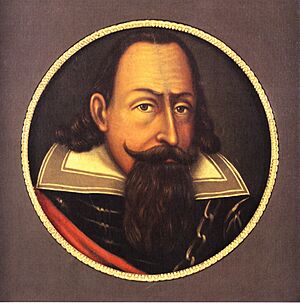Philip II, Duke of Pomerania facts for kids
Quick facts for kids
Philip II, Duke of Pomerania-Stettin
|
|
|---|---|

Duke Philip II of Pomerania-Stettin
|
|
| Born | 29 July 1573 Franzburg |
| Died | 3 February 1618 (aged 44) |
| Noble family | House of Griffin |
| Spouse(s) | Sophia of Schleswig-Holstein-Sonderburg |
| Father | Bogislaw XIII, Duke of Pomerania |
| Mother | Clara of Brunswick |
Philip II, Duke of Pomerania-Stettin (born July 29, 1573 – died February 3, 1618) was a duke who ruled a part of Pomerania called Pomerania-Stettin. He was in charge from 1606 to 1618. Philip is famous for being one of the most artistic dukes from Pomerania. He married Sophia of Schleswig-Holstein-Sonderburg in 1607, but they did not have any children.
Contents
Early Life and Education
Philip was born on July 29, 1573, in a place called Neuenkamp. This area later became Franzburg in Pomerania. He was the oldest son of Duke Bogislaw XIII and Clara of Brunswick. Philip grew up in his father's home in Barth.
As a child and teenager, Philip received a good education. He was very interested in art and science. By the age of twelve, he already had a collection of books and pictures. He even wrote his first scientific papers when he was seventeen. Philip truly loved art, not just for show. At eighteen, he wrote that he enjoyed collecting books, portraits, and old coins. He felt these collections helped him learn and be useful to others.
Travels and Experiences
Like many young princes of his time, Philip went on many long trips. These journeys, known as "grand tours," took him to different countries and royal courts in Europe. He spent two years in Italy, but his trip ended early in 1598 when his mother became very ill.
Becoming Duke
In 1603, Philip's uncle, Duke Barnim X, passed away. This meant Philip's father, Bogislaw XIII, became the ruling duke of Pomerania-Stettin. However, Bogislaw XIII felt he was too old to govern. So, he made Philip II the governor of Pomerania-Stettin.
When his father died in 1606, Philip became the ruling duke himself. During his time as duke, he was known for supporting the arts. He also created new rules in 1616 about how people worked on farms. These rules set up a legal system for farm workers.
Family Life and Health
On March 10, 1607, Philip married Sophia. She was born in 1579 and lived until 1658. Sophia was the daughter of John II, Duke of Schleswig-Holstein-Sonderburg. Sadly, Philip and Sophia did not have any children. In fact, none of the last generation of Pomeranian dukes had children. This meant that after Philip's brother, Bogislaw XIV, died, the family line of the Dukes of Pomerania ended.
Philip often felt sad and had a weak body. From the early 1600s, he suffered from gout, a painful condition. This made life harder for him, and he spent less time in public. Because of his health, he could not attend his brother Francis's wedding in 1610. He also missed an important meeting with Emperor Matthias in 1613. In 1612, he visited a health spa, but it did not help much. Philip died on February 3, 1618, before he turned 50.
Supporting the Arts
Philip II was a great supporter of art. Most of the important artworks he ordered were made between 1606 and 1618. Some of these works included:
- A special monument for his ancestor, Duke Barnim VI, in a church in Kenz-Küstrow.
- A "signting book" with many portraits of his family members.
- An art gallery.
- The Map of Lubinus, which was the first accurate map of the Duchy of Pomerania.
- The Meier Court.
- The most famous was the Pomeranian art cabinet. This amazing collection was unfortunately destroyed by fire during World War II.
Philip worked closely with an art dealer named Philip Hainhofer from Augsburg. They wrote many letters to each other. When Hainhofer visited Pomerania in 1617, he wrote a detailed diary. This diary describes the art collection at the Ducal Castle in Szczecin.
When Philip died in 1618, many of the artworks he had ordered were not finished. His brother and the next duke, Duke Francis, was not as interested in art. He paid to finish the works Philip had started. But after that, the time of great art at the Pomeranian court came to an end. One of the projects finished under Francis was a new part of the Ducal Castle. Most of Philip's art was kept in this new section.

